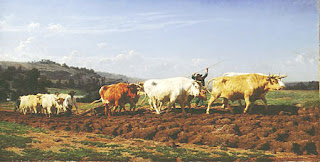Professor Cacoilo
Art & Women
March 7, 2017
"Despite biblical teachings against them, they became writers, artists, merchants, and nuns, and ran the kingdom when their husbands were away at war" (Guerilla Girls, 19).Girls were expected to get married as young as the age of twelve. Becoming a nun offered an escape from marriage and more privileges than married women. Those privileges included literacy and art. Nuns were writers and artists, and responsible for various unaccredited pieces of work. Herrad of Landsberg was a nun at Hohenburg Abbey in Alsace. She is the author of an encyclopedia called Hortus Deliciarum, which contains many poems and artwork. CLVT Nation Bizarre refers to Herrad as "an early hero in the struggle to get education to women."
During the Renaissance, women were given some "rights", if you can even call them that. Those include saving her tainted reputation by marrying her rapist, getting an abortion approved by the Catholic Church (even though it could be deadly), and, probably the best of all, prostitutes, actresses, and aristocrats were allowed to wear underwear! The Renaissance also offered women who weren't nuns some more room to participate in the arts, though they were still far from equal to men. Women who belonged to families of artists, and had access to art studios, may have been allowed to work on art. One of the women who worked in her father's studios was Artemisia Gentileschi. She was very talented, even as a young teenager, however, after being raped by one of her father's colleagues, followed by a literally torturous trial, Artemisia became and strong, badass woman, which reflected in her art. The most famous example of this is her painting, Judith Slaying Holofernes, 1612. The Guerilla Girls illustrate Artemisia saying:
"Many artists show Judith looking away as she cuts off Holofernes' head, they think a woman could not bear to look while doing such a deed. I will show Judith intent on accomplishing her mission, and unafraid to face carnage and death." (Guerilla Girls, 35)
 |
| Artemisia Gentileschi, Judith Slaying Holofernes, 1612 This painting is so important because all of the male artists depicted Judith as if she almost did not actually kill Holofernes since women were weak and incapable of committing such violence. However, Artemisia knew a thing or two about badass women, and she made sure to paint Judith as one as well. |
The 19th century was "the beginning of women's long struggle for equality", as stated by the Guerilla Girls (page 47). While male painters sexualized women for their own personal satisfaction, women artists showed they can be just as talented. Rosa Bonheur became one of Europe's most beloved artists in the 19th century. When speaking of her success, Art History Archive explains, Rosa Bonheur established herself as "the foremost 'animalier,' or animal painter, linked with landscape painting and the Realist tradition." Her painting, Plowing in the Nivernais, won her an award at Salon 1841. She also received commissions for her work. Rosa was lesbian and proud. She even got a permit to cross-dress. She was unafraid to be completely herself. Though women of the 19th century were far from equal to men, there was progress being made, and the fearless women artists illustrated common struggles for all women. These inspiring women were ahead of their time, and undoubtedly paved the way for feminists today.
 |
| Rosa Bonheur, Plowing in the Nivernais, 1848 Rosa's love for animals was evident in her paintings. She became known for illustrating the beauty of nature, which was refreshing during a time when male artists were sexualizing naked women. |
Work Cited:
The Guerilla Girls, The Guerilla Girls' Bedside Companion to the History of Western Art
cvltnation.com
arthistoryarchive.com

No comments:
Post a Comment